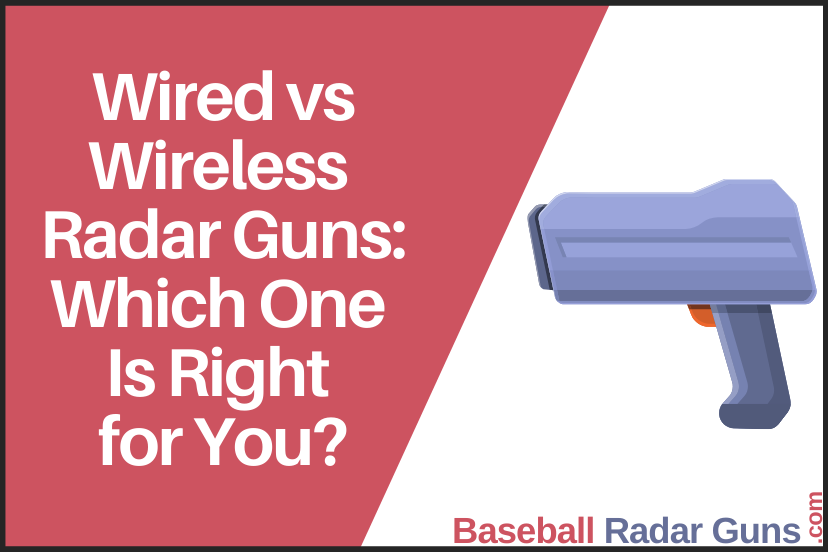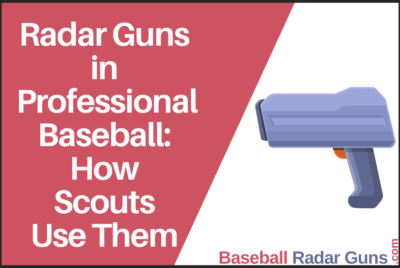Comparing Wired vs. Wireless Radar Guns: Which One Is Right for You?
*We may earn a commission for purchases made using our links. Please see our disclosure to learn more.
Radar guns are essential tools for baseball coaches, players, and scouts. They measure the speed of a baseball pitch as it leaves the pitcher’s hand and travels to the plate. Radar guns come in two varieties: wired and wireless. Both types of guns have their advantages and disadvantages. For this reason, understanding the differences between them before deciding which one is right for you is crucial. Likewise, you’ll find some specific features for only wireless or wired baseball radar guns. This can determine whether it will meet your needs or not.
This extensive article will help you understand the two types of Baseball radar guns, wired and wireless design. Furthermore, you’ll learn the key factors to consider when purchasing a wireless or wired model. It will help guide your decision-making before making a purchase. For further clarity, each design’s specific pros and cons are listed herein. Let’s get started.
Table of Contents
Overview of Wired and Wireless Radar Guns
Wired and wireless baseball radar guns are two types of devices used to measure the speed of a baseball pitch. Wired designs are the traditional type of radar gun. These models have been around since the 1950s. They use a cable to connect the gun to a power source and require a direct line of sight to the pitcher. Professional teams often use wired models. And it’s quite common in organized baseball leagues.
Contrarily, wireless radar guns are a more modern and do not require a physical connection to a power source. Also, they do not need a direct line of sight to the pitcher. These can be handheld or mounted on a tripod. They use Bluetooth technology to transmit data to a laptop or tablet. Pro and semi-pro teams and even leagues like Little League Baseball often use wireless. Coaches and scouts also use them to evaluate the performance of potential players.
Considerations When Choosing Between Wired and Wireless Radar Guns
As briefly mentioned, deciding whether to purchase a wired model or a wireless design can be tricky. To help guide your decision-making, below are key factors to consider:
Cost Comparison
The two designs have become a popular tool for coaches and scouts in Baseball sport to measure the speed of a pitcher’s pitch. With technological advances, both have become more accurate and affordable for various budgets. Nevertheless, there are still differences between them.
Regarding cost, wired radar guns are typically the more affordable option. This is because most reliable products cost less than wireless radar guns. The only downside is that they require a wired connection to a power source to use. On the contrary, a wireless radar gun can be used without a power source.
Wireless radar guns are usually more expensive than their wired counterparts. However, the models offer more features. They are usually more user-friendly and have various features like a Bluetooth connection, app compatibility, and more. The accuracy of most wireless designs is superior as they allow for more precise measurements. However, their higher cost source can be a limiting factor for potential buyers with small budgets.
Installation and Maintenance Requirements
Both wired and wireless baseball radar guns must be set up and maintained over a period of use. However, the level of installation and maintenance required varies based on the specific design and manufacturer.
Wired radar guns require a physical connection between the gun and the radar display unit, such as a dedicated cable or an Ethernet connection. The installation of the gun itself usually involves mounting the gun on a tripod or other stable surface. This ensures that the device is correctly aligned with the playing field. Maintenance of wired radar guns requires periodic gun and display unit cleaning. Also, users need to check the cable connections regularly.
Meanwhile, modern designs offer more flexibility in installation and setup. This is because no cables are required. The main requirement for installation is to ensure the gun is correctly aligned with the playing field. Likewise, the gun should be placed within range of the display unit. Maintenance is usually minimal and generally consists of replacing the battery in the gun when necessary. As with wired designs, you must also clean it regularly and keep it in a dust-free environment.
Reliability and Durability
Here is another key factor to consider when assessing your best option. Both types are durable and reliable. However, wired radar guns are more reliable due to their physical connection. Wired radar guns are less likely to be affected by interference from other wireless devices. Additionally, the connection in wired design is not as susceptible to disruption or interruption. Wireless radar guns may be more convenient. However, they are susceptible to interference and connection issues.
Regarding durability, both wired and wireless radar guns are highly durable and can withstand the wear and tear of regular use. Nevertheless, wireless radar guns may be more prone to physical damage due to their lack of a physical connection. But, there is a lower chance of suffering from electrical damage due to their wireless connection. Contrarily, wired designs tend to be more reliable and have a longer life span. Meanwhile, wireless radar guns can still provide reliable readings and are relatively easy to maintain. Both can provide accurate readings and are highly durable, though wired radar guns are usually the most reliable and long-lasting option.
User Experience
As stated earlier, wired baseball radar guns provide accurate and reliable readings. Nevertheless, they must be connected to a power source, which can be a hassle. Wireless radar guns are more convenient since they are battery-powered. Yet, many users have noted inaccuracy in some models of wireless baseball radar guns. Both types provide a great user experience, especially for coaches and scouts who need to accurately measure a pitch’s speed.
When using a wired radar gun, the user must connect the gun to a power source and aim it at the pitched ball. Consequently, users can read the speed of the pitch on the LCD display. On the other hand, a wireless radar gun requires the user only to press a button to activate it and then read the speed on the display. The user experience with a wireless radar gun is much more convenient and user-friendly since the user does not bother connecting a power source. Hence, it’s left to you to decide your level of convenience.
Wired vs. Wireless Baseball Radar Guns: Pros and Cons
The comparison above shows that each design of the Baseball radar gun features specific benefits and downsides. To ease your comparison further, consider the particular pros and cons of both wireless and wired radar guns for baseball sport below:
Pros and Cons of Wired:
Pros:
• More reliable than wireless systems due to fewer interruptions
• More accurate readings due to lack of interference
• No need for battery replacements or charging
• Easy to use and setup
Cons:
• Limited range due to wires
• Costly due to installation and maintenance of wiring
• Cable clutter can be an issue
• Not as portable as wireless systems
Pros and Cons of Wireless:
Pros:
• Easy to set up and use.
• Portable and lightweight.
• Accurate readings.
• No cables or wires needed.
• Can be used indoors or outdoors.
Cons:
• Requires a power source to recharge.
• Not as accurate as traditional wired radar guns.
• Possible influence of environmental factors like wind and humidity.
• More expensive than wired radar guns.
• Susceptible to interference from other wireless devices.
Conclusion
It is apparent that wired and wireless have their advantages and disadvantages. Wired radar guns are reliable and accurate. However, they can be tedious to arrange and require a long cable. On the other hand, wireless radar guns are easy to set up and use. Meanwhile, they can be prone to interference and have shorter operational ranges. Ultimately, which one is right for you depends on your needs. A wired radar gun is your best bet if you need the most reliable and accurate readings. Meanwhile, a wireless radar gun may be the better choice if you need something that is easy to set up and use. Also, remember to consider the size of your pocket before making your final decision.




